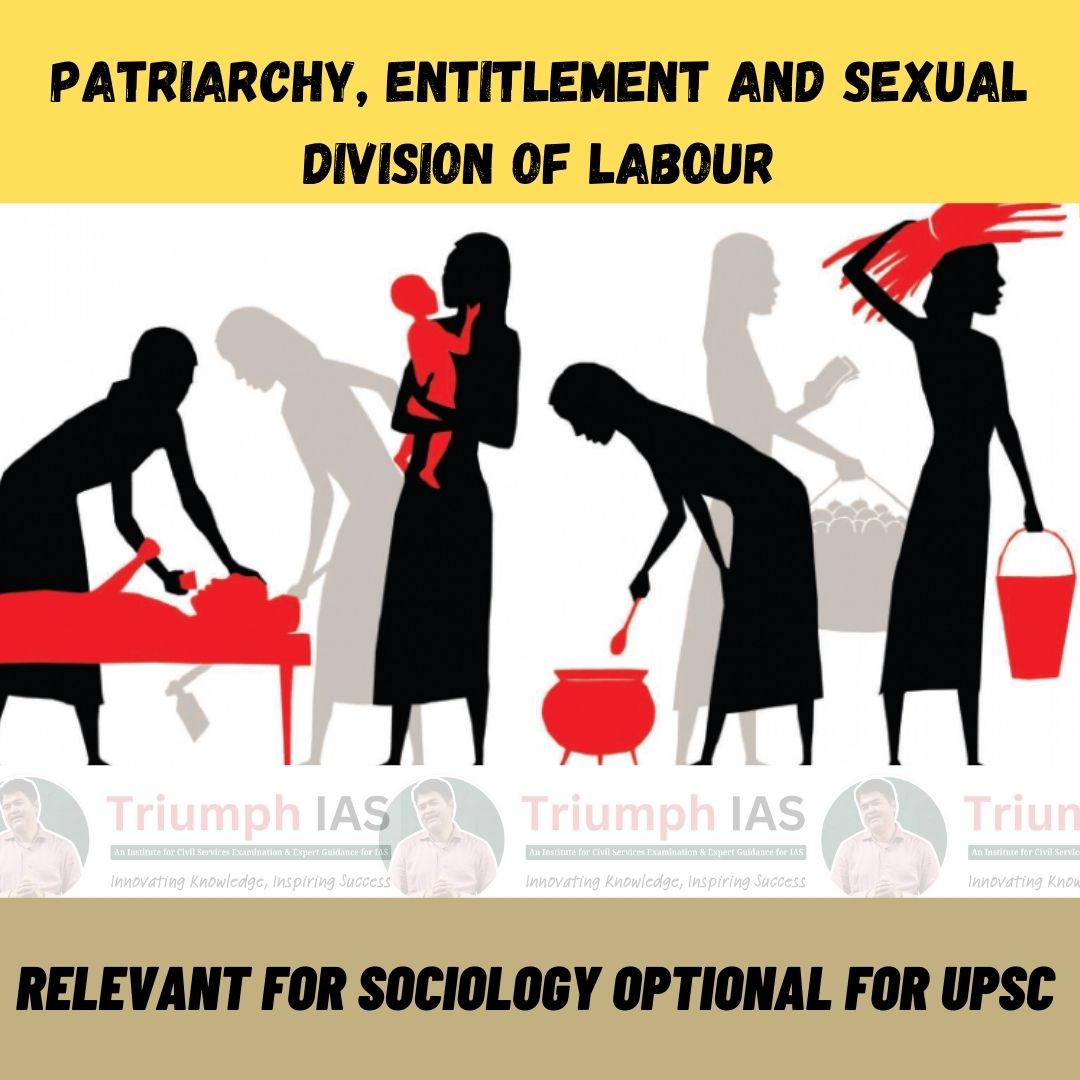Patriarchy, Entitlement and Sexual division of labour
(Relevance For Sociology Optional Paper I)

IntroductionHumans have existed for over 400,000 years, and throughout this time, our social systems have evolved continuously. Some changes are evident and tangible, while others are more subtle yet influential. This evolution is also reflected in our social structure and the division of labour. Humanity faces a crucial situation: either break free from the constraints of a patriarchal society, male entitlement, and traditional division of labour, or remain bound by these regressive views. While these three facets can be studied individually in an academic setting, in the real world, they collectively act as shackles for women. Therefore, it is essential to address them together at some point. Aristotle once stated that a woman was a mutilated man, and Sigmund Freud claimed that a woman’s anatomy was her destiny, asserting that a normal human was male. Such misogynistic comments from influential intellectuals, which lack scientific evidence, have harmed the cause of gender equality. Contrary to these views, the discourse on equality is now at its peak. Women constitute almost half of the world’s population, and their contributions are invaluable. Shifting from a non-technical perspective to a more technical one, we delve into the realms of sociology, anthropology, history, feminism, and economics to understand this topic comprehensively. History of Patriarchy, Entitlement, and Division of LaborPatriarchy stands as a primary obstacle to the advancement of women, both in the home and the workplace. The fundamental concept remains that men hold control. This phenomenon is prevalent in almost every society, and understanding the societal structure regarding the positioning of women is crucial to dismantling the system. Why focus on patriarchy among the trio of issues? The answer is straightforward: the social structure that dictates property ownership, household management, and labor roles, along with patriarchy as a social system, completes the puzzle. Today’s world is a shared achievement of both men and women. Although women now hold positions of power in political and economic realms (relatively speaking), society remains predominantly male-dominated. Originally, patriarchy implied that a ‘head man’ made decisions for everyone in the family, including other men. Over time, the concept has evolved to signify power control held by men in society. Men dominate key institutions, often excluding women. The exploitation of women is amplified by exaggerated biological differences, suggesting that women should be assigned more docile tasks while men take on more labor-intensive roles. To understand this further, we need to examine the history of how work has been divided by gender. Male Entitlement
Sociologist term male entitlement when males hold the position of powers in important social institutions such as top positions in religious institutions, law institutions, political institutions, etc. Feminists argue that because of this male entitlement, women have never been able to climb to important positions and the balance could only be formed through the reservation. A counter view to this is made by men’s scholars who claim that there is a typical hegemonic masculinity, which is mostly represented by a bourgeoise, chauvinistic, misanthropic male who holds a high position in these institutions, at least in contemporary times, is because of his socio-economic status and not because of his gender. The Indian government has also taken steps to ensure women representation in the government by proposing to reserve at least 33% of seats in the Lok Sabha for women. The bill has not been passed but there are signs that it will be implemented. In the corporate sector, it is mandatory for companies to at least have one female member on the board of directors. In economic terms, feminists argue that it is because of male entitlement that women’s contribution to the GDP is not accounted for. According to a study, women do two third of the world’s work while men do only one-third of the world’s work but are paid way more than women. In some instances, women do a dual task of childcare and earn a livelihood. It is often observed that women take more responsibility in taking care of the family whilst men, especially in the poorer sections of the society, get engaged in crime early or drugs and some claim that this is because of the entitlement given to men, which creates a sense of superior being in them from a time they are babies. Archaic practices such as female foeticide and preference of a male child over a female one have led to a varied sex ratio in India and other developing countries. This can be again attributed to the male entitlement that is prevalent in society. The view stems from historic times when rulers had to fight in wars or engage in battle. However, as society is changing to a more non-combat one, this view has to and is in some terms, fading away. Sexual Division of Labour (SDL)Historically, the division of labor to gather food for the family was a reality for hunter-gatherers. Anthropologists study remaining tribal groups to understand societal structures and women’s roles, known as the behavioral ecological perspective. The life history theory posits that both sexes decide whether to use resources for existing offspring or produce new ones, aiming for maximum reproductive fitness. Females are typically more certain of their offspring and face fewer mating opportunities and greater risks compared to males. However, this theory doesn’t apply universally to all tribal groups. Another theory, natural selection, suggests that males prioritize mating efforts while females focus on parental concerns. This results in women performing more docile tasks, like collecting vegetables and caring for cattle, while men do more labor-intensive work. This view isn’t universally accepted and is mixed with the idea of promiscuity, where both males and females were encouraged to be promiscuous, leading to a communal group where children couldn’t be traced to only two individuals. Steven Kuhn from the University of Arizona proposed that the sexual division of labor began after the Upper Palaeolithic age (50,000 to 10,000 years ago). Various hypotheses explain the origins of SDL, such as the Provisional Household theory, which suggests that pair bonding led to women caring for children while men collected food. The optimal foraging theory posits that to maximize calorie intake per unit time, it was rational for men to hunt resources difficult for women, who also assumed parental duties, to gather. Men then passed the calorie-dense resources to women. Another explanation involves spatial abilities, with research indicating men are marginally superior in mental rotation and assessing horizontality and verticality, while women excel in spatial memory. Cognitive differences have been suggested as a reason for SDL, but history shows SDL is a relatively recent phenomenon. Contemporary Views on All Three FacetsAccording to functionalist sociologists, males and females have been assigned distinct roles to ensure the functioning and continuity of the family, resulting in social differentiation. In this framework, women take on the role of homemakers due to their childbearing capacity, while men are the breadwinners. Conflict sociologists argue that men primarily owned private property, which led to depriving women of their rights. Women became dependent on men (fathers, male kin, or husbands) for their livelihood, resulting in a loss of economic independence and wealth. Feminists contend that gender differentiation is cultural rather than biological. They believe that men assigned domestic chores to women not because of biological differences but due to societal coercion. Historians suggest that the war-engaging behavior of mankind led to women being assigned more domestic roles, considering them biologically weaker. Women were seen as breeders, which contributed to polygamy in various societies and religions. This mutual point highlights that patriarchy and the Sexual Division of Labor (SDL) developed together, with male entitlement as a by-product. Men began to dominate fields, and religious institutions acted as catalysts. For instance, Eve is portrayed as the evil one in Genesis, and the Hindu lawmaker Shalu stated that women are unfit to enjoy freedom due to their perceived weakness. Similarly, in Daoism, the yin and yang concept assigns the dark side to female emotions, considered vices. However, not all people and philosophies adhered to these views. Albert Camus celebrated women’s freedom to wear whatever they wanted at the beach. In Hinduism, female deities hold significant importance and are worshipped by both sexes. In Greek mythology, many goddesses were worshipped universally. |


One comment